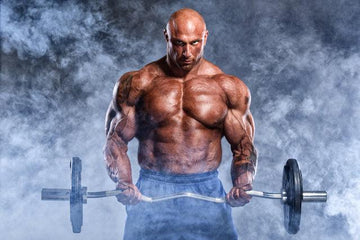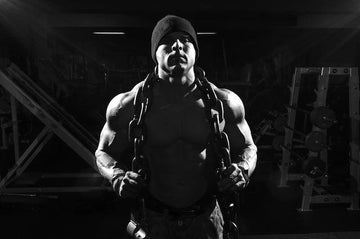

Functional Training for Strength and Mass
Table of Contents
Today’s Athletes need to be bigger, faster and more explosive than ever before. Men and women pride themselves at pushing up big numbers on the bench press and show off the upper bodies tone muscles. What’s everyone’s photo for “I AM FIT?” The bicep curl… you don’t pull your pant legs down to show off quad development. True be told leg training, to be productive is an intense, brutal session and there is no way around it. Leg training is hard but dynamic because it includes compound movements like squats, leg presses and dead lifts while elevating your testosterone levels and call upon other muscle groups–leg workouts are almost a total body effort so to speak. Men already know the benefits of higher testosterone level however women tend to repel from the thought of increased levels. Women actually need testosterone, as part of the mix of hormones that keep mood, energy levels, sex drive, and bodily functions working smoothly. Controlled studies show that slightly increasing testosterone levels in aging women restores sexual drive, improve mood and well being, as well many other health-enhancing benefits. Leg day is the easiest session to skip in the gym. Leg training is tough but it’s worth it, No matter how big your upper body is, having small legs will make your physique look odd at the least, if not ridiculous.
Almost all physical activities incorporate elements of force, quickness, duration, and range of motion. Exercises to overcome resistance are strength exercises. Speed exercises maximize quickness and high frequency. Exercises of long distance or duration, or many repetitions are endurance exercises. Maximum range of motion results in a flexibility movement. Exercises with complex movements are known as coordination exercises. Strength, speed, and endurance play an important role in reaching high levels of performance. It’s easy for endurance athletes to forget all about the gym and spend the majority of their time working on their sport of choice. With this type of program, they’re missing two key components for successful performance: power and strength. RUNNERS TEND TO AVOID THE WEIGHT ROOM LIKE IT’S ON FIRE, There are well-documented studies showing that weightlifting is tremendously beneficial for running in many ways that decrease injury risk and improve performance. While that may sound contradictory because many fear that strength training would slow down a subsequent training session the truth is that positioning the exercises right before your high intensity workout will help you run faster. In fact, at least five different scientific studies have shown that a high intensity strength session activates the nervous system, increases the “firing rate” of nerve cells which control muscles, and improves the overall “recruitment” of muscle fibers during a workout.
Looking for the ideal leg work out to take your training to the next level can be surprisingly difficult. Sports specific, is a common term used, accurately used? No functional training is more accurate. Functional training builds muscle, improves endurance, prevents against injury, and puts athletes in the best situation to apply their skills in their respective sport. The same holds true for even if your sport is walking, jogging, or hitting the gym once or twice a week.
As with any muscle group, choosing the most challenging movement and doing it first in your workout when your energy levels are high will pay the greatest dividends.
BODYWEIGHT JUMP SQUAT
- Place your fingers on the back of your head and pull your elbows back so that they’re in line with your body.
- Stand as tall as you can with your feet spread shoulder-width apart.
- Your lower back should be naturally arched.
- Brace your core and hold it that way.
- Dip your knees in preparation to leap.
- Explosively jump as high as you can. When you land, immediately squat down and jump again.
BOX SQUAT JUMP
The muscles are in a relaxed pre-working state at the beginning of the exercise. The body must overcome the weight and inaction of both the body and external weight. The box supports the weight of the body and dumbbell at the beginning of contraction, not the muscles.
A large amount of force is created from this relaxed position in a short amount of time. This exercise relies more on starting strength than the traditional box squat since the athlete actually jumps.
Starting position: Place a dumbbell across your shoulders. The elbows will be facing straight ahead with the fingers on top of the dumbbell. Execution: With the back of your heels placed against the box, sit way back onto the box. Do not round your low back on the box, keep a flat and tight lower back position. As you sit on the box relax your hip flexors, but keep everything else tight. From this position jump as hard and as fast as possible straight up.
Reset after each jump. Do not use a barbell for this exercise, with a barbell the elbows and arms are turned out and opened up. This is a quick jump and you want to keep the body tight throughout the jump. A barbell will put the body is a vulnerable position, we are not working with heavy weights and there is no reason to add a balance element to this exercise.
Dumbbell Lateral lunge
Jumping Lunges
Start in a standard lunge position. Your chest should be upright and in line with your toes. Your back leg should be almost fully extended with your knee just off of the ground.
Start with a small counter movement and explosively jump up and switch your legs in the air.
Land with soft knees by catching yourself before your back knee hits the ground. Use your arms to help propel yourself up.
ONE-Legged Deadlifts:
Single-leg strength and stability are extremely important for both performance and injury reduction and thus should be made a priority. Even though the movements are performed on one leg, they involve the whole body, when perform them properly.
Your neck should be in neutral position. You shouldn’t look up or down. Your back should be arched. Just as it is with traditional deadlift, the chest should be up. Your support leg shouldn’t be stiff; it needs to be a little bent. The moving leg, shouldn’t be freely hanging in the air, keep it straight back with heel pointing to the ceiling. Keep in mind that your foot shouldn’t be pointing on the side! Grab a pair of dumbbells and stand on your left foot. Lift your right foot behind you and bend your knee so you’re right lower leg is parallel to the floor.
Bend forward at your hips, and slowly lower your body as far as you can. Pause, and then push your body back to the starting position. As you come up, think about using your gluteus to push your hips forward instead of lifting from your back. Keep core engaged and chest up during the entire movement.
Athletes also benefit from shortening rest breaks in between exercise sets. Physically, shorter rest periods (60 seconds or less) have a more positive effect on growth hormone levels compared to lengthier ones. You will also improve your ability to handle the accumulation of lactate and lactic acid (terms often used interchangeably). The transferability over to sport is very obvious. Mentally, shorter rest periods increase willpower and improve your ability to compartmentalize discomfort. The better you are at managing discomfort, the better you will be as an athlete.

















